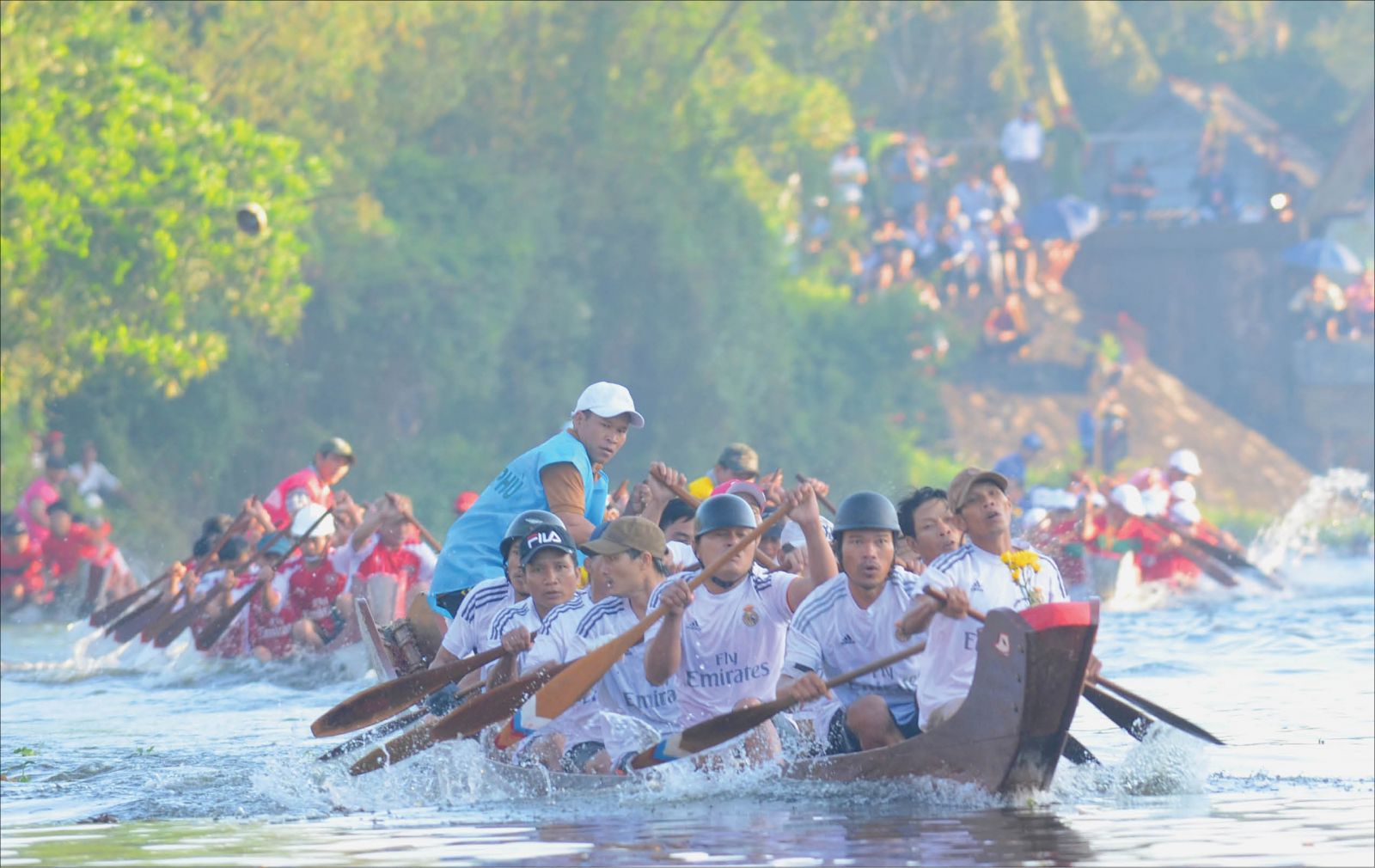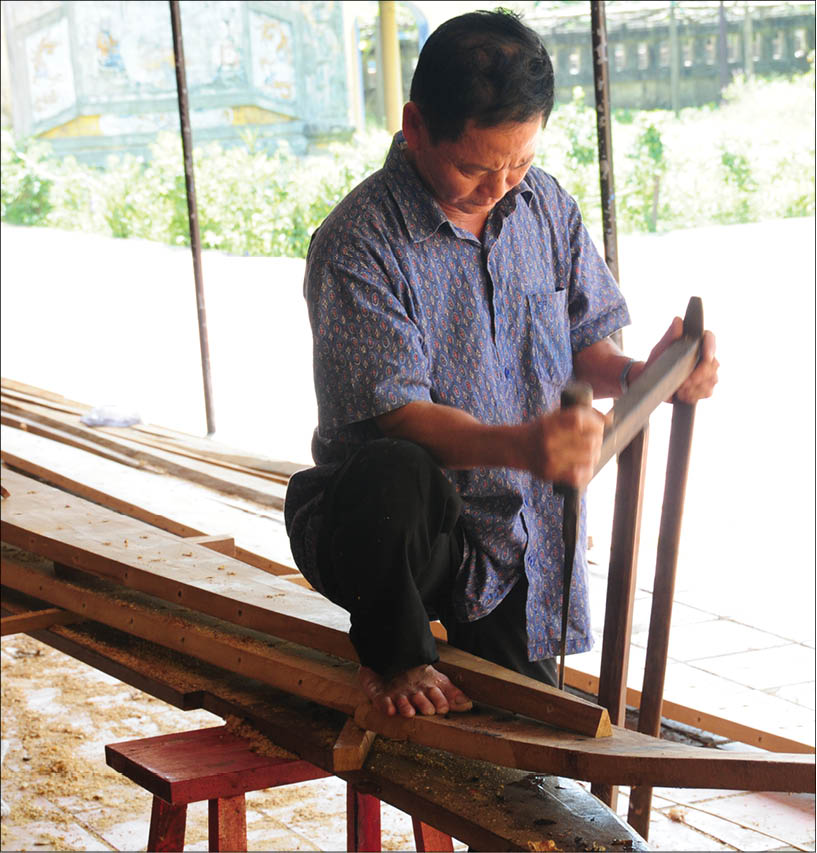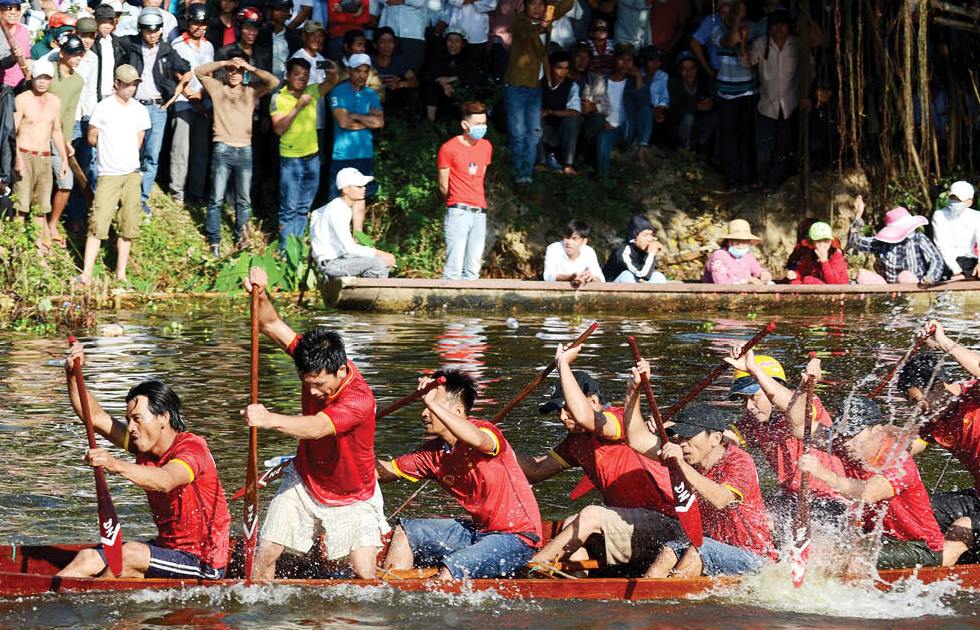It is linked to rituals such as peace-pleading ceremony or praying for successful fish catches, etc. Behind the exciting activities in this custom, there are stories about the profession of building racing boats that few people know.
(*) Referring specifically to long and narrow boats designed for racing, called “trải” in Vietnamese.

A boat race in Vuc river. Photo: Vo Nhan
The craft of making racing boats is different from other crafts in that it is more than a way to earn a living. Not only do the craftsmen have to possess special skills and talents, they are also required to protect professional knowledge, put themselves under the high pressure generated from their duties and accountability to the community, particularly those attached to highly spiritual codes of conduct. For this reason, although there are a high number of carpenters in Hue, few choose to be racing boat makers. Hence, Mr. Le Van Vinh’s family and their well-known racing boat workshop in Duong No village deserve even more appreciation.
…
As a man in his fifties (born in 1966), Mr. Le Van Vinh from Duong No village (Phu Duong commune, Phu Vang district) is a special person with a special handicraft. Born into a family with 4 generations of carpenters, he followed the profession under the guidance of his father, Mr. Le Thien, since he was over 10 years old.
Apprenticed in his own family, where he was an adored son, he, however, did not receive much favor under his strict father’s training. Starting with doing errands such as sweeping wood chips, cleaning tools, carrying wood, etc., and familiarizing himself with saws, chisels and planes, he was trained by his father to be patient, careful and to “know the craft” from the age of 15.
Being a gifted, bright and hardworking person, he soon received high expectations from his father. Mr. Vinh would follow him on trips to all over the countryside in Quang Binh, Quang Tri and Thua Thien Hue provinces to build houses or do carpentry work. Furthermore, in Pho Loi, where life is vastly connected to the water, people’s livelihood is dependent on fishery and, more importantly, the solemn and exciting boat racing festival is a lifestyle highlight held every year. By a fortunate serendipity, his family got to learn the craft of making and fixing racing boats.

Mr. Le Van Vinh at his racing boat workshop. Photo: Hoang Hoa
Since 1990, Duong No’s villagers invited Mr. Sat, a senior craftsman from Lai neighborhood, Hai Trinh village (Phu Thanh commune, Phu Vang district) over to make racing boat at the That Toc (Seven Clans) house of worship, next to the village’s temple. As a carpenter, Mr. Vinh was allowed to closely follow the work. Seeing his own suitability for this craft, he was excited and enchanted by the prospect of being a traditional racing boat builder. However, as conventions had it, this craft was not allowed to be passed on to somebody outside of the clan, let alone someone outside of the village. Therefore, Mr. Sat the craftsman only gave him some general guidance, not really going into the process of putting a boat together.
Along with the villagers, Mr. Vinh was only allowed to participate in some basic steps such as stripping tree bark, tying holes, etc., but with his passion, bright mind and the knowledge he already had from working as a carpenter, Mr. Vinh left a good impression on the strange craftsman. This brought him an opportunity to enter a new profession.
After a long time studying, calculating and taking notes in the nights he stood guard over the boat under the assignment of the village committee, and with the guidance of his respected master, Mr. Vinh managed to gather sufficient knowledge about the methods and techniques in making racing boats. Two months later, his pilot racing boat was successfully built. Gradually, the blueprints were then gradually systematized and perfected with his efforts, allowing racing boats with advanced features and better performance to be assembled.

A boat race on Vuc river. Photo: Vo Nhan
Mr. Vinh's talents gradually became recognized by many people in many places. Accordingly, he received many invitations to build and fix their village’s traditional racing boats. His skills in boat making not only allowed him to build racing boats for Duong No village but also accompanied him to many wetland villages in Quang Binh, Quang Tri, Thua Thien Hue, or even farther North to Nghe An or farther South to Dak Lak.
Unfortunately, nowadays, the demand for racing boats has decreased since the festivals are no longer held at the scale they used to be, and boat races have been gradually replaced by sampan races. The villages do not need to own a racing boat anymore. Rather, they could rent one from other villages. Furthermore, a racing boat can last very long, about 15 to 20 years, hence the demand for new ones to be made is sluggish. Mostly they only need to be refurnished before the races. For these reasons, it is quite difficult for the profession of making racing boats to thrive.
As a rule, the secret of this craft can only be circulated within the clan, not to be disclosed to outsiders. In addition, it requires the craftsmen to be able to stand firm under competitive pressure before the races. Therefore, not many people choose to be racing boat builders. This profession is at risk of being discontinued when many artisans from the old generation passed away without anyone to inherit their craft.
Mr. Le Van Vinh’s family is one of the few still practicing this traditional craft. Looking at it not just as a means of living, his family are also passionate about preserving and developing this unique intangible heritage, which is on the verge of being lost. His role in passing on this handicraft to the younger generation and his passion are highly appreciated by his three sons, who have followed their father to be racing boat builders. They all hope to bring Duong No village’s racing boat building profession to a higher level.
Behind the boat racing festival, with its sacred rituals and exciting, unique festivities, few people know about Mr. Le Van Vinh, a highly skilled racing boat builder who contributes to the race’s success. Through their diligent and silent work, the racing boat builders of Mr. Vinh’s family are nurturing and carrying on the handicraft of making racing boats, which very few people in central Vietnam still practice.
Should there be a river and water museum in Hue, present there must certainly be the exhibits which carry the essence of Duong No’s racing boat making craft, made by such skill craftsmen as Mr. Vinh’s family.
By Hoang Hoa
